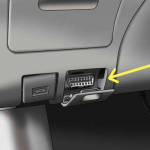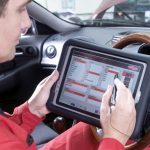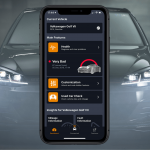Introduction to OBD2 Software
OBD2 software has transformed the way mechanics and DIY enthusiasts interact with vehicle diagnostics. This technology offers real-time data from various sensors, allowing users to monitor engine performance, diagnose issues, and optimize efficiency on the go. Imagine you’re working on your car and suddenly notice that the check engine light has come on. With OBD2 software, you can connect your device, retrieve live data, and see exactly what’s happening under the hood without needing to guess.
Equipped with a simple user interface, these software tools read and interpret the onboard diagnostics data from a vehicle’s onboard computer systems. They can display:
- Engine RPM
- Vehicle speed
- Sensor readings (like coolant temperature and air-fuel mixture)
- Trouble codes
Having this information right at your fingertips makes troubleshooting significantly more manageable.
Benefits of Live Data Monitoring
The advantages of live data monitoring through OBD2 software are plentiful:
- Immediate Feedback: With real-time insights, users can immediately identify problems before they escalate into costly repairs.
- Precision Tune-Ups: DIYers can adjust their vehicle settings accurately based on direct data rather than relying solely on experience or theoretical knowledge.
- Enhanced Vehicle Performance: Continuous monitoring can lead to improved fuel efficiency and overall vehicle performance.
- User-Friendly Interfaces: Most OBD2 software options come equipped with intuitive displays, making it accessible even for novices.
- Cost Savings: DIY repairs supported by accurate diagnostics can help avoid unnecessary trips to the garage.
By leveraging OBD2 software for live data monitoring, users can take charge of their vehicle’s health and gain deeper insights into how to maintain and enhance performance effectively.
Understanding Real-Time Engine Analysis
Importance of Real-Time Data Analysis
Real-time data analysis has become a game changer in the world of automotive diagnostics. For mechanics and DIYers alike, being able to access and interpret engine data live can mean the difference between a minor fix and a major overhaul. Imagine you’re out on a long drive, and your engine starts to stutter. With real-time engine analysis, you can quickly pinpoint whether it’s a fuel issue or maybe a problem with your ignition system—all without pulling over to consult a manual.
The importance of this immediate insight cannot be overstated. It allows for:
- Timely Decisions: Identifying issues on the fly can prevent more serious (and costly) problems down the road.
- Safety: Recognizing engine anomalies in real-time helps ensure the safety of the vehicle’s occupants.
- Enhanced Efficiency: Immediate feedback on sensor performance can lead to better fuel economy and reduced emissions.
Components of Engine Analysis
Understanding the components of engine analysis is key to utilizing real-time data effectively. Here are some critical elements to consider:
- Engine Control Unit (ECU): The brain of the vehicle that processes sensor data and commands engine functions.
- Sensors: Various sensors provide essential data, including:
- Oxygen sensors (O2 sensors)
- Mass airflow sensors (MAF)
- Coolant temperature sensors
- Data Interpretation Tools: OBD2 software translates raw data into actionable information, making it easier to understand.
- Graphical Displays: These visual representations of data trends help spot issues at a glance, allowing for quick assessment and actions.
By understanding these components, users can optimize engine performance, increase longevity, and enhance overall vehicle reliability—making real-time engine analysis an indispensable tool in automotive care.
Popular OBD2 Software for Live Data Monitoring
Top OBD2 Software Tools
When it comes to tapping into the wealth of data your vehicle provides, choosing the right OBD2 software is crucial. Thankfully, there are numerous tools available, each offering unique features tailored to different user needs. Whether you’re a seasoned mechanic or a DIY enthusiast, you have several options that can significantly enhance your experience.
- Torque Pro: A favorite among many enthusiasts, Torque Pro provides extensive customization options and offers real-time data monitoring.
- OBD Auto Doctor: This intuitive tool is excellent for beginners. It offers user-friendly interfaces for easy diagnostics while still maintaining a comprehensive data set.
- Car Scanner: Perfect for both new and experienced users, Car Scanner offers a wide range of features from real-time monitoring to diagnostic code reading.
Software A Features and Benefits
Torque Pro is renowned for its robust functionalities. Some standout features include:
- Real-time data display: Monitors parameters like speed, RPM, and fuel consumption.
- Customizable dashboard: Users can set up the display to show exactly what they want.
- Fault code diagnostic feature: Quickly retrieves trouble codes, saving time on troubleshooting.
This rich functionality helps users tailor their diagnostics to their specific needs.
Software B Features and Benefits
OBD Auto Doctor caters to those who prioritize simplicity without sacrificing effectiveness. Key features include:
- User-friendly interface: Ideal for those who may not be tech-savvy.
- Comprehensive diagnostic tools: Offers live data, stored fault codes, and overall vehicle health reports.
- Graph plotting: Visual data representation for easier interpretation of trends.
This simplicity is perfect for DIYers looking for effective yet accessible tools.
Software C Features and Benefits
Car Scanner stands out with its dynamic approach. Its features encompass:
- Wide vehicle compatibility: Works with multiple vehicle makes and models.
- Detailed diagnostic capabilities: Provides in-depth inspection of various system components.
- Live data streaming: Users receive continuous updates on vehicle performance metrics.
This versatility makes Car Scanner appealing to a broad audience, allowing users to dial into specific features as needed.
Choosing the right OBD2 software can elevate your vehicle maintenance game, providing real-time insights and streamlining the diagnostic process.
Using OBD2 Software for Engine Performance Optimization
Real-Time Monitoring for Performance Tuning
Once you have chosen the right OBD2 software, the real magic happens when you leverage real-time monitoring for engine performance tuning. Picture yourself on a winding road, making adjustments to your vehicle settings based on live feedback from your engine. With OBD2 software, you can tune your engine to optimize power, improve fuel efficiency, and enhance overall drivability.
Real-time monitoring allows you to:
- Adjust air-fuel ratio: Fine-tuning this parameter can lead to significant performance gains and better fuel economy.
- Optimize ignition timing: Using live data to see how your engine responds to timing adjustments can help you find the sweet spot for performance.
- Monitor engine temperature: Keeping an eye on temperature readings ensures that your engine is running efficiently without overheating.
Many enthusiasts report noticeable differences in throttle response and acceleration after implementing these changes using OBD2 data.
Troubleshooting with Live Data Analysis
Live data analysis not only helps enhance performance but is also a powerful tool for troubleshooting. Imagine driving down the highway when your dashboard warning light flickers on. Instead of panicking, you pull out your OBD2 tool and begin analyzing real-time data.
Some key benefits of troubleshooting with live data include:
- Immediate diagnosis: Quickly identifying issues such as faulty sensors or performance dips helps you take preventative measures before reaching a garage.
- Data-driven repairs: Instead of guessing which component may be faulty, you get precise information on what needs attention, saving time and money.
- Trend analysis: Monitoring live data over time can reveal patterns that indicate wearing components, allowing you to address problems proactively.
Utilizing OBD2 software for both performance tuning and troubleshooting offers a comprehensive approach to vehicle care. It empowers users to maintain optimal engine performance while addressing any issues as they arise. With the right tools and knowledge, you can truly unlock your vehicle’s potential.
Integrating OBD2 Software with Vehicle Systems
Compatibility with Different Vehicle Models
Integrating OBD2 software with your vehicle system opens up a world of diagnostics and performance tuning, but compatibility is a key consideration. Not all vehicles communicate in the same way, and understanding how your vehicle interacts with OBD2 software is crucial.
Most modern vehicles manufactured from 1996 onward are OBD2 compliant, meaning they can interface with a variety of diagnostic tools. However, older models or certain specialized vehicles may present limitations. Here’s what you need to consider for compatibility:
- Vehicle Year: Ensure your car is OBD2 compliant. Typically, vehicles manufactured in or after 1996 will be compatible.
- Vehicle Make and Model: Some OBD2 software works better with specific brands. For instance, certain software may offer enhanced features for Ford or GM vehicles.
- Connection Type: Most OBD2 tools connect via Bluetooth or USB, so double-check the compatibility of your device’s connection type with the software you intend to use.
Before diving into setup, it’s wise to do a quick compatibility check to avoid any hurdles during integration.
Data Interpretation and Analysis
Once your OBD2 software is connected to your vehicle, it’s time to harness the power of data interpretation and analysis. Understanding the data being pulled from your vehicle’s sensors is essential for accurate diagnostics and performance enhancements.
Key aspects of data interpretation include:
- Real-Time Monitoring: Observing metrics such as engine RPM, fuel trim levels, and coolant temperatures helps identify trends that can indicate potential issues.
- Trouble Code Reading: Learn to decode the diagnostic trouble codes (DTCs) generated by your vehicle. Each code corresponds to a specific issue (like P0420 for catalytic converter efficiency), allowing you to make informed repairs.
- Graphical Representation: Many OBD2 software applications offer graphical displays of data trends. These visuals can help you quickly pinpoint anomalies or performance dips.
Gathering and interpreting the right data through OBD2 software allows for informed decisions regarding repairs and optimizations. Whether you’re diagnosing a minor hiccup or tuning your vehicle for peak performance, mastering these skills empowers you to make the most of your vehicle’s potential.
Enhancing Diagnostic Capabilities with OBD2 Software
Advanced Features for Diagnosing Engine Issues
As vehicle technology evolves, so too do the capabilities of OBD2 software. The advanced features now available for diagnosing engine issues can make even the most complex problems manageable. These tools have become essential for both professional mechanics and DIY enthusiasts who wish to dive deep into their vehicle’s systems.
Some advanced features to look out for include:
- Freeze Frame Data: When an issue occurs, the ECU captures “freeze frame” data, which shows the exact conditions at the time of the fault. This information can be invaluable for diagnosing intermittent problems.
- Enhanced Diagnostic Codes: Beyond the standard OBD2 codes, some software offers manufacturer-specific codes that provide more detailed insight into what might be going wrong.
- Graphing and Logging: Advanced OBD2 tools allow you to graph live data readings over time, making it easier to identify patterns, gauge performance, and spot anomalies that may indicate an underlying issue.
Using these features can elevate your diagnostic process, reducing guesswork and ensuring that you make targeted, effective repairs.
Real-World Applications of Live Data Monitoring
The real-world applications of live data monitoring through OBD2 software are extensive, offering tangible benefits in everyday vehicle maintenance and performance improvements. For instance, consider a weekend DIY project where a car owner decides to tune their vehicle for better performance. By connecting to OBD2 software, they can monitor the air-fuel ratio and adjust it in real-time, leading to noticeable power gains on the road.
Additionally, live data monitoring proves invaluable for preventive maintenance. By regularly checking parameters like coolant temperature and engine RPM, users can spot small problems before they escalate into larger, costly repairs.
Here are a few practical scenarios where OBD2 software shines:
- Frequent Fuel Economy Checks: Logging fuel consumption data can help identify when your vehicle isn’t operating efficiently, signaling a possible need for maintenance.
- Tracking Sensor Performance: If a vehicle is experiencing sluggishness, monitoring sensor outputs like the MAF and O2 readings can pinpoint which one is causing the issue.
Incorporating OBD2 software into regular vehicle diagnostics not only streamlines the repair process but ultimately promotes a healthier, better-performing vehicle. Armed with live data and advanced diagnostic features, users are better prepared to tackle any engine discrepancies that arise.
Tips for Effective Live Data Monitoring
Best Practices for Utilizing OBD2 Software
To get the most out of your OBD2 software, it’s essential to adopt best practices that ensure you’re harnessing the full potential of live data monitoring. As you delve into real-time engine diagnostics, a few key tips can significantly improve your overall experience and results:
- Familiarize Yourself with Your Software: Take the time to explore your OBD2 tool. Knowing where to find and how to interpret different readings will save you time in critical situations.
- Regularly Update Software: Keeping your OBD2 software updated ensures access to the latest features, bug fixes, and compatibility improvements with newer vehicle models.
- Perform Routine Checks: Make it a habit to connect your OBD2 software regularly, even when no warning lights are present. This proactive approach helps you catch minor issues before they develop into significant problems.
- Use Data Logging: Consider using the data logging feature provided by your software. This allows you to record live data while driving, offering insights into how your vehicle behaves under different conditions.
Implementing these practices can streamline your diagnostic processes and increase your readiness for any vehicle issue that may arise.
Maximizing Benefits of Real-Time Analysis
Once you’ve mastered the basics, it’s time to maximize the benefits of real-time analysis through your OBD2 software. Here are some strategies to consider:
- Set Specific Goals: Before analyzing data, specify what you need to achieve—whether it’s improving fuel efficiency or diagnosing a recurring engine issue. This focused approach leads to more effective use of your time and resources.
- Combine Insights: Compare live data with historical trends. This context can provide you with deeper insights into your vehicle’s performance over time and help you identify persistent or recurring issues.
- Collaboration: If you’re working with other car enthusiasts or mechanics, share data insights. Collaborating can open up different perspectives and solutions to the problems you may face.
- Get the Right Accessories: Tools like vehicle scopes or multimeters can enhance your setup, enabling you to record and review detailed data that could lead to better diagnostics.
By employing these strategies, you’ll not only enhance your proficiency with OBD2 software but also ensure your vehicle remains in peak condition. Real-time monitoring grants you the ability to actively manage performance, making you more empowered as a vehicle owner. Grab your tool and dive into the wealth of data; your engine will thank you!
Future Trends in OBD2 Software Development
Innovations in Live Data Monitoring
As technology continues to evolve, the landscape of OBD2 software development is set to see some exciting innovations, particularly in the realm of live data monitoring. Imagine a future where not only can you closely monitor your vehicle’s performance, but also predict potential issues before they even occur. This is becoming increasingly feasible with advancements in artificial intelligence and machine learning.
Some key innovations on the horizon include:
- Enhanced Predictive Analytics: Expect OBD2 software to incorporate predictive algorithms that analyze historical data to forecast engine problems. This proactive approach can save time and money on repairs.
- Real-Time Cloud Integration: Future software is likely to leverage cloud technology, allowing for real-time data analysis and remote diagnostics from anywhere. Imagine checking your car’s status while at work or on the go.
- Compatibility with Smart Devices: As our devices become smarter, so too will OBD2 software. Integration with smartwatches or smartphones can provide instant alerts or recommendations based on live data.
These innovations promise to make vehicle monitoring more efficient, user-friendly, and informed.
Predictions for the Future of Engine Analysis Software
Looking ahead, the future of engine analysis software is poised to revolutionize how we approach vehicle diagnostics and performance management. Here are a few predictions for what’s to come:
- Greater Customization: The future will see OBD2 software allowing even more tailored experiences, enabling users to tailor their dashboards according to specific preferences and needs.
- Increased User Education: With a push toward more intuitive interfaces and educational resources, users of all skill levels will be able to harness the power of OBD2 software for advanced diagnostics.
- Integration with Electric Vehicles (EVs): As the automotive industry shifts toward electrification, OBD2 systems will adapt to diagnose and monitor the unique components of electric powertrains.
As we stand on the brink of these exciting advancements, it’s clear that OBD2 software will increasingly become a cornerstone of modern vehicle management. By keeping abreast of these trends, mechanics and car enthusiasts will be better prepared to leverage new tools, ensuring their vehicles remain at peak performance while enjoying a seamless user experience. The future of engine analysis is bright, and the possibilities are endless!






